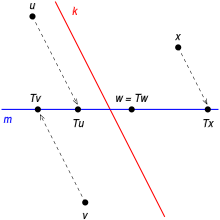Projection (linear algebra)
In mathematics , a projection or projector is a special linear mapping ( endomorphism ) over a vector space that leaves all vectors in its image (a subspace of ) unchanged.
If a base of is chosen appropriately , the projection sets some components of a vector to zero and keeps the others. This clearly justifies the term projection, such as the illustration of a house in a two-dimensional floor plan.
definition
Let be a vector space . A vector space endomorphism is called a projection if it is idempotent , i.e. if it holds.
properties
A projection can only have the numbers 0 and 1 as eigenvalues . The eigenspaces are
The total space is the direct sum of these two subspaces :
The illustration is clearly speaking a parallel projection along .
If there is a projection, then there is also a projection, and the following applies:
Projections and complements
If there is a vector space and a subspace, then in general there are many projections on , that is, projections whose image is. If there is a projection with an image , then there is a complement to in .
Conversely, if a complement of in , so , then each can as a sum with clearly specified and represent. The endomorphism of , which assigns what belongs to each , is a projection with an image and a core . Projections and decompositions into complementary subspaces correspond to one another.
Orthogonal projection
If a finite-dimensional real or complex vector space with a scalar product , there is a projection along the orthogonal complement of for every sub-vector space , which is called “orthogonal projection onto ”. It is the uniquely determined linear mapping with the property that for all
- and
applies.
If an infinite-dimensional Hilbert space , then this statement with the projection theorem applies accordingly to closed sub-vector spaces . In this case, continuous can be chosen.
Examples
As simple examples can be for each vector space the identity and the figure for state as trivial projections (which can be represented by the unity or zero matrix).
Let it be the mapping of the plane in itself that is passed through the matrix
is described. It projects a vector onto , i.e. orthogonally onto the x-axis. The eigen-space for eigenvalue , i.e. the core, is spanned by , the eigen-space for eigenvalue , i.e. the image, is spanned by. The projector is the orthogonal projection on the y-axis.
In contrast, for example, is through the matrix
The described image of the plane is also due to a projection, but not an orthogonal projection. Its image is again the x-axis, but its core is the straight line with the equation .
application
In quantum mechanics , in connection with the measurement process , one speaks of a projection of the state vector ψ, the precise interpretation being described below:
- As a measurement result , only one of i comes. A. question an infinite number of so-called eigenvalues of the observed observables (ie the assigned self-adjoint operator in the state space of the system, the so-called Hilbert space ). The selection is made randomly ( Copenhagen interpretation ) with a certain probability, which is not required here.
- The calculation of the probability for an eigenvalue (measurement result) takes place, among other things, with the aid of the projection onto its eigenspace .
The totality of the projection operators obtained in this way is “complete” for a given measurand and results in the so-called spectral representation of the observables.
swell
- Gerd Fischer : Linear Algebra. Vieweg-Verlag, ISBN 3-528-03217-0 .
- Dirk Werner : Functional Analysis. 6th, corrected edition, Springer-Verlag, Berlin 2007, ISBN 978-3-540-72533-6 , page 161.






































